Abstract
With the development of the maritime economy, sea traffic is becoming more and more crowded, and sea accidents are also increasing. Research on maritime search and rescue decision-making technology cannot be delayed. This paper studies the maritime search and rescue decision algorithm, based on the optimal search theory. It also analyzes three important concepts: Probability of containment (POC), probability of detection (POD), and probability of success (POS) involved in the maritime search and rescue decision-making process. In this paper, the calculation methods of POC and POD variables have been improved, and the search success rate has been improved to some extent. Finally, an example analysis of the maritime search and rescue incident is given. Through verification, the algorithm proposed in this paper can support maritime search and rescue decisions.
1. Introduction
Maritime search and rescue is not recent but has been valued since the Second World War, following the search for enemy submarines by the US Army [1]. However, with the development of maritime search and rescue technology, there are still shortcomings, such as low efficiency in search and rescue and slow response. For example, the MH370 [2] or Air France 447 events [3] caused heavy casualties, due to slow search and rescue response, insufficient search and rescue resources, and inefficient search and rescue, and some of the wreckage has not been found so far.
In recent years, domestic and foreign scholars have done a lot of research on the issue of maritime search and rescue decision-making. Among them, George Kimball and Bernard Koopman et al. created the modern optimal search theory [4]. Thomas M Kratzke and L.D.Stone et al. used the optimal search theory for maritime search and rescue, and proposed the concept of maritime search success rate (probability of success, POS) [5]. Koczkodaj et al. studied the emergency resource scheduling problem in drift target search and rescue [6]. Xiao Wenjun and Du Panjun et al. studied the maritime search and rescue prediction model system [7]. Wang Boyan thoroughly studied the problem of determining the optimal search area at sea [8]. Ren Jiaying studied the optimal planning and methods of maritime search and rescue [9]. However, there is not much improvement in the calculation of the search success rate. This paper improves the calculation method and accuracy of the probability of containment (POC) and the probability of detection (POD), and then improves the POS calculation model to increase the probability of success.
This article focuses on search and rescue decision-making in the Bohai Sea area, where sea accidents frequently occur. In the process of search and rescue missions, common tools such as radar, satellite, fishing boats, warships, or search and rescue boats are usually used for the auxiliary search, with on board SAR software impregnated with GIS technologies [10], as well as means of communication. But these operations are based on a key element: It is the search and rescue plan. For the design of this plan, SAR plan development specialists, under the supervision of a coordinator, rely on probability methods to determine the probability of containment (POC), the probability of detection (POD), and the probability of success (POS) [11].
These are the basic building blocks of a SAR plan that will be the focus of this paper, while seeking to improve the design of the plan.
2. Materials and Methods
2.1. Description of Study Area
In recent years, due to its special geographical location and climatic conditions, the Bohai Sea has been frequently involved in maritime traffic accidents. The Bohai Sea is located in the North Temperate Zone and has complex weather conditions [12]. It is an area with frequent severe weather. Complex and harsh marine weather and the resulting marine disasters are important factors in the traffic safety problems in the Bohai Sea [13].
According to incomplete statistics, since 2016, there have been hundreds of major maritime traffic accidents in the Bohai Sea area, accounting for 10–15% of traffic accidents in coastal areas across the country. Although it has declined, compared with previous years, it is still at a high level. Among them, the damaged ships in the accident were mostly in Shandong, Liaoning, and Hebei. Figure 1 and Figure 2 show the distribution map of the sea search and rescue cases in China in 2017 and the histogram of case data.
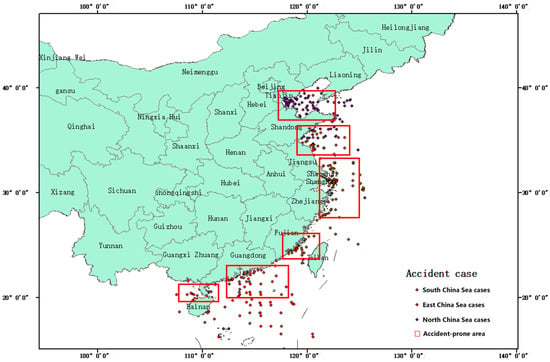
Figure 1.
2017 China Sea Area Case Distribution Map.
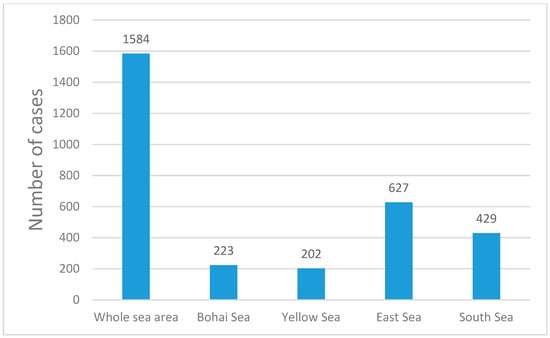
Figure 2.
2017 China Sea Area Case Comparison Chart.
It can be seen from the above two figures that the Bohai Sea area has a higher accident rate than other sea areas, so it is more suitable as a research area for maritime search and rescue decisions.
2.2. Description of Experimental Data
In emergency decision-making of marine accidents, information such as wind, waves, and currents in the accident area is crucial for the development of search and rescue operations [14,15]. This paper extracts the drift prediction of search and rescue targets by extracting the marine dynamic environment data such as wind, wave, and current from the European Meteorological Center, and visualizes the marine dynamic environment data (see Figure 3). The NetCDF data model [16] is used to integrate and manage the marine dynamic parameter data, which improves the multi-dimensional expression and analysis ability of ocean dynamic parameter data.
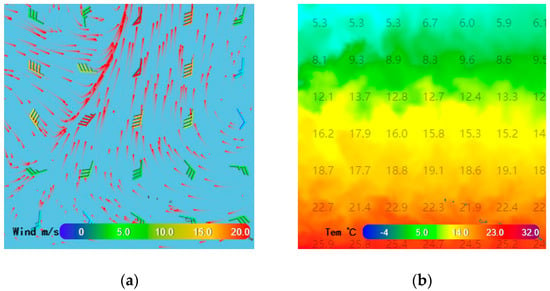
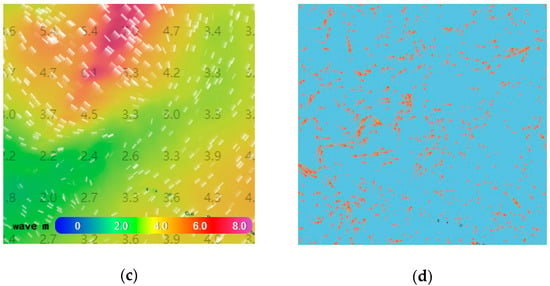
Figure 3.
(a) A visual representation of wind field, (b) a representation of sea temperature, (c) a representation of wave field, (d) and a representation of flow field.
2.3. Description of the Probability of Containment
In the process of completing and optimizing the marine search and rescue plan, the likelihood of containment is the first probability to find. Primordial in the establishment of the plan, this probability would require a lot of considerations if it was to deduce a new method to optimize the results of the plan being defined [17]. In fact, the probability of containment is the measure that makes it possible to evaluate the chances of existence of the object sought by the planners [18]. This object can be a ship, an aircraft, an object of value, and, especially, a human. This probability is based on algorithms or well-founded formulas that obviously meet the criteria of the laws of probability.
To begin any process of calculating the probability of confinement, it would be necessary to first define the search area [19], transform it into a probability map by cutting it into several cells, containing points, and then defining the air of containment based on the cell that contains more points. These points are the different possible positions of the search object after its drift occurs with sea and wind currents [20]. We regard the drift of the maritime search and rescue target as the movement of the particle with the current, so the Lagrange particle tracking algorithm [21] is used to calculate the displacement of each particle. The specific calculation formula is as follows:
where represents the displacement of the particle, is the drift coefficient, is the diffusion coefficient, and is an independent random number [22].
By solving the Lagrange equation, the displacement of each particle is determined and then the dynamic tracking of the particle is realized. Several formulas, such as that of the simplified search planning method (SSPM), mentioned in “Theory of Research: A Simplified Explanation” [23], the Bayesian method [24,25,26], and the Basic Probability Calculation Method, are generally used to calculate the POC. In fact, these methods are different. Among them, the Bayesian algorithm is mainly used for POC updates. It is based on the change of the search area’s POC after the first search is completed, to calculate the POC of the new area in the secondary search process.
The basic probability calculation method is only based on the ratio of the number of scatter points in the current search area to the number of scatter points in the total search area to determine the POC value. This paper introduces the concept of density ratio in the calculation of POC, aiming to improve the calculation accuracy of POC.
The Density Ratio
The density ratio is an important variable in POC calculation, it is mainly related to overall density () and containment density (). Among them, the density of the primary area or research area would be referred to as overall density, which is the ratio of the number of scatter points in the containment area to the size of the containment area; the density in the secondary area or containment area would be referred to as containment density, which is the ratio of the number of scatter points in the overall area to the total size of the area. These are the concepts to be known after finding the demographic density, which makes it possible to deduce these two concepts. They will be used later to determine the main concept, which is the ratio of density. From the moment the marine search and rescue planning section defines the containment area, the latter and all that is included becomes a different entity from the global area. In fact, calculating the density ratio is like evaluating the occupancy rate of a population of a part of the overall area in relation to the occupation of the total population of the overall area.
Thus, the density ratio is a proportionally between the containment density and the overall density. It can also be referred to as the percentage rate of density, because it also replaces the detection probability coverage rate to determine the POC. The formula involved is as follows:
where is the number of points in the containment area, is the total number of points, is the containment area, is the overall area, is the containment density, is the overall density, is the density ratio, and is the probability of containment.
The specific probability distribution map is shown in Figure 4.
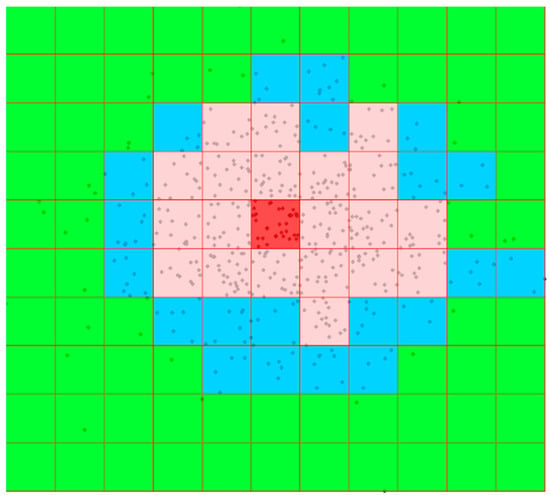
Figure 4.
Search area probability distribution map.
The color in the figure illustrates the gradient of the POC, its value decreasing from the inside out. Among them, red indicates the highest value, peach is the second, blue is lower, and green is the lowest.
2.4. Description of the Probability of Detection
After defining the containment area and determining the probability of containment, the next step is to determine the probability of detection [27].
Probability of detection is the probability associated with the maritime search and rescue unit. This probability is mainly due to the efficiency of the survey engines and available sensors. According to the famous Koopman formula, the search effort, or the area actually covered by search and rescue teams (Z, whose formula is: or ) [28], is the important factor when it comes to calculating the probability of detection. In reality, the weighting of the speed (v), time (t), and sweep width (W) is effective if the planners are in possession of the information of its variables [29].
What can be done if this information did not exist as in the laboratory?
As a result of this situation, the first thing to do is register a regular quadrilateral within the containment area or circumscribe this quadrilateral around the containment area. In order to maximize the results of detection probability and success probability, it is advisable to circumscribe the quadrilateral by surrounding the first cells closest to the containment area.
Next, we need to determine which search method to use. Indeed, there are several types of plotting techniques. For example, we have the extended square search pattern, sector search pattern, creeping line search, parallel sweep search [30], and others (see Figure 5). To determine the path and sweep width values, the parallel sweep search must be the most suitable search method.
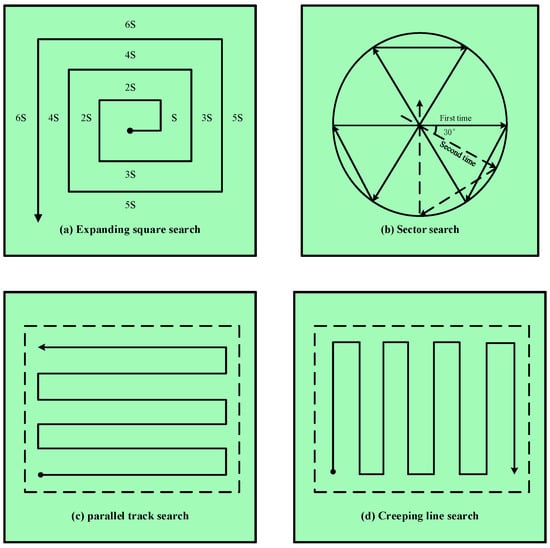
Figure 5.
Different search modes in maritime search.
To draw the tracking line, the center of each cell was chosen to cross the line, with the center of the departure cell as the starting point and the point of arrival as the center of the last cell.
In fact, the path (L) would be equal to the total number of cells, the number of which will be subtracted a cell. This number will then be multiplied by the double of the radius of a cell, or by the diameter of a cell. One cell is subtracted from the total number of cells because the first and last cells have only Rays.
Sweeping width refers to the effective distance that the detector can detect the target of search and rescue in a specific search and rescue environment. It is an important indicator of the effectiveness of search and rescue operations. For the calculation of sweeping width (W), it is necessary to obtain statistical analysis of a large amount of experimental data and real case data [31,32]. From a geometric point of view, the sweep width satisfies the horizontal curve (see Figure 6), that is, the cumulative detection probability curve based on the lateral distance.
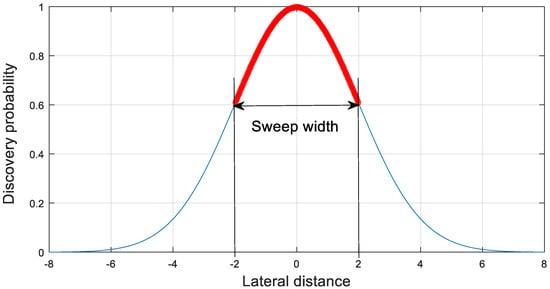
Figure 6.
Horizontal curve function.
The horizontal curve varies for different detectors, search environments, and search targets. Usually a detector corresponds to a set of lateral distance curves. In theory, the curve can be drawn on the basis of a large amount of experimental data by means of statistical estimation.
In the figure, the abscissa represents the lateral distance, where the positive number represents the saccade distance on the right side of the detector. The negative number represents the saccade distance on the left side of the detector and the ordinate represents the detection probability, that is, the probability of being able to detect a target at a lateral distance. As can be seen from the figure, when the lateral distance is 0, the probability of detection is 1. The larger the lateral distance, the smaller the probability of detection. Eventually, it tends to zero. As the lateral distance changes, when it is exactly a certain value, such that the upper and lower areas of the curve are equal, the value is the sweep width of the detector in a given environment.
The sweeping width has a great relationship with the meteorological conditions of the accidental sea area and the type of search and rescue targets. By analyzing various influencing factors, the correction coefficient of the width of the sea sweep can be further obtained, so that the calculation of the sweep width is more accurate. The specific sweep width correction factor table is as follows (Table 1):

Table 1.
Sweeping width correction coefficient table under different conditions.
Coverage (C), search effort (Z), and the detection probability can be calculated based on the length of the search route (L) and the sweeping width (W). The specific formula is as follows:
where is the total number of cells covered, is the number of cells covered minus one cell, is the correction factor, is the cell radius, is the cell area, is the containment area, is the sweep width, is the effective area covered, is the coverage probability, and is the probability of detection.
2.5. Description of the Probability of Success
Knowing the probability of containment and detection, we can find the probability of success (POS). It is an important indicator of search and rescue activities. The larger the POS, the greater the probability that the search target will be successfully found in the search area. The specific calculation formula is as follows:
3. Results
3.1. Determine the Search Area
In this paper, the “cell iterative search” method [33] is used to select the optimal search area, which is the area with the highest search success rate, and then calculate the inclusion probability of the area for the search target. Figure 7 shows the probability distribution (see Figure 7a) and search method (see Figure 7b) of the optimal search area. When the POC is large enough, the probability that the search target exists in the search area at this time can reach 100%. However, at this time, the search area is often large, which makes the search resources unable to perform a full effective coverage search on the search area, and the POD becomes lower, and finally, a lower search success rate is obtained. When the search area is small, the search resource can perform a full coverage search on the search area, so that the POD is large. However, at this time, the POC is low, due to the small area, and finally, a low search success rate is obtained. Therefore, to improve POS, we must start with both POC and POD.
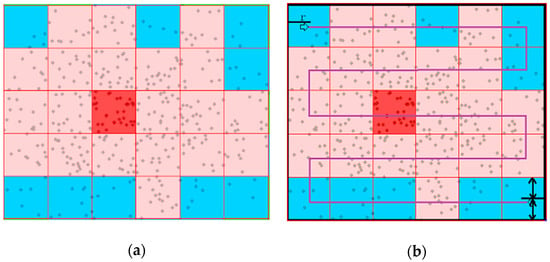
Figure 7.
(a) Probability distribution of the optimal search area; (b) route design of the search process.
Taking an accident case in Bohai as an example, this paper first randomly generates 500 points according to the Monte Carlo method [34,35], each point represents a location where a search and rescue target may exist at a certain moment. Then, according to the Graham scan algorithm and the minimum rectangle generation algorithm, a rectangular search area containing all the scatter points is generated.
3.1.1. Monte Carlo Algorithm Introduction
The Monte Carlo algorithm is also known as a random sampling technique. Its basic idea is that according to the changing law of the random problem to be sought and the statistical law of the physical phenomenon itself, or artificially constructing a suitable probability model, a large number of statistical experiments are carried out according to the model, so that some of its statistics are just waiting, seeking a solution to the problem. In the process of calculating the estimated value, the higher the number of simulations, the higher the calculation accuracy. This paper simulates 500 particles as the possible positions of search and rescue targets, and deduces the dynamic tracking of particles according to the wind, flow force, and displacement of the search target. Compared with the traditional analytical method, the Monte Carlo algorithm improves the accuracy of the drift prediction results and reduces the size of the optimal search area.
3.1.2. Graham Scan Algorithm Introduction
The Graham scan method is an algorithm based on polar angle sorting [36]. The specific algorithm steps are as follows:
Step 1. Place all the points in the Cartesian coordinate system and use the point with the smallest ordinate as the origin (Such as P0 in Figure 8a). Here, the Mercator projection method is used to convert the latitude and longitude coordinates into Mercator projection coordinates. The conversion formula is as follows:
where is angle parameter, is latitude, is longitude, and is earth radius.
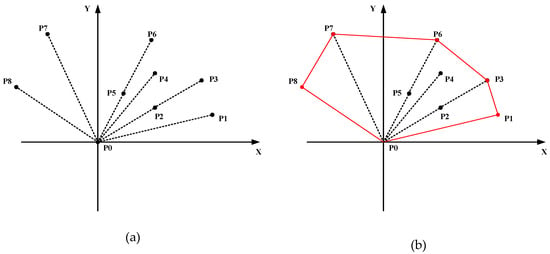
Figure 8.
(a) Distribution of experimental points in a Cartesian coordinate system; (b) final results of the Graham algorithm.
Step 2. According to the angle between each point and the origin, sort the points in order from small to large. When the angle is the same, the point closer to the origin is in front. After sorting is completed, the first point and the last point must be the points on the convex hull. As shown in Figure 8, we sort all points by P1 to P8. P1 and P8 are points on the convex hull.
Step 3. Put P0 and P1 into the stack, and consider the point after P1 as the current point to find the next convex point.
Step 4. Connect P0 and P1 to obtain a straight line, L, and judge the position of the current point with respect to the straight line, L. If the current point is on the left side of L or on line L, step 5 is performed; if the current point is on the right side of L, step 6 is performed.
Step 5. Use the current point as a convex hull point and put it on the stack.
Step 6. The top element of the stack is not a convex point; pop the top element of the stack and perform step 4.
Step 7. Determine if the current point is the last element. If yes, it ends. The final result is shown in Figure 8b; if not, then the next point is taken as the current point, and step 4 is continued.
Step 8. After the convex hull is generated, an outer envelope is generated by using each side of the convex hull as a boundary. Compare the size of each outer rectangular area and use the outer rectangle with the smallest area as the final rectangular overall search area.
3.1.3. Minimum Rectangle Generation Algorithm Introduction
The algorithm is mainly used to normalize deformation of convex polygons. The main steps are as follows:
Step 1. Select one edge of the convex hull as the starting edge, and rotate the convex hull around the left end of the selected edge so that the edge is parallel to the horizontal axis of the coordinate. Calculate and save the coordinates of the outer rectangle, the edge number, and the rotation angle.
Step 2. Select other edges in sequence. Calculate and save the coordinates of the outer rectangle, the edge number, and the rotation angle, according to the method in the first step.
Step 3. Compare the area of each outsourcing rectangle, where the smallest area is the minimum outsourcing rectangle that is required.
Example rendering of the final overall search area is shown in Figure 9.

Figure 9.
Search area display.
3.2. POC Calculation
In the process of calculating the POC, the search area is first divided into grid cells of the same size. After the color is graded according to the method described above, the grid cell with the largest POC value is found as the initial search rectangle, and the POS value is calculated. Then add one or more columns along each side of the search area to generate a new search rectangle and calculate its POS value. Compare the size of the POS value of the two search rectangles before and after. If , the new search rectangle is reserved, otherwise the original search rectangle is retained. Repeat according to the above process until the POS no longer increases, then the current rectangle is used as the final search area.
After determining the search area, the POC value of the selected search area can be calculated according to Equations (2)–(5). The specific element values are shown in Table 2.

Table 2.
Probability of containment (POC) calculation element table.
As can be seen from the above table, the search area selected by this method has a higher POC value. The specific probability distribution diagram is shown in Figure 10.
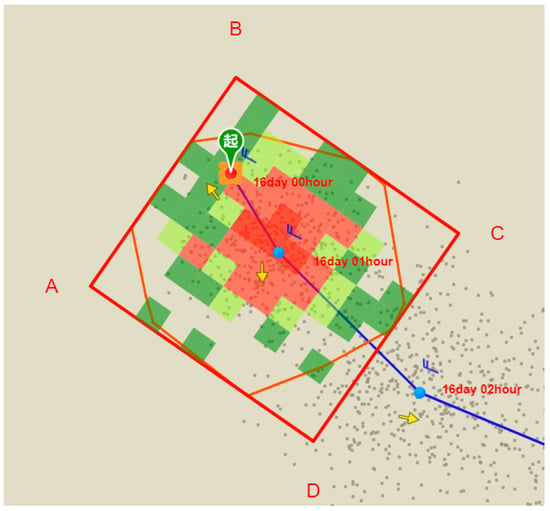
Figure 10.
Instance probability distribution map.
3.3. POD Calculation
The POD value of the current search rectangle needs to be calculated during the calculation of the POS value for each iteration. After determining the final search area, the POD values of the selected search area can be calculated according to Equations (6)–(10). The specific element values are shown in Table 3.

Table 3.
Probability of detection (POD) calculation element table.
3.4. POS Calculation
After determining the inclusion probability and the detection probability, the search success rate can be calculated according to Equation (11). The specific element values are shown in Table 4.

Table 4.
Probability of success (POS) calculation element table.
As can be seen from the above table, the probability of successfully finding a search and rescue target in the selected area is 0.7056. The specific search plan and search area parameters are as shown in Figure 11:
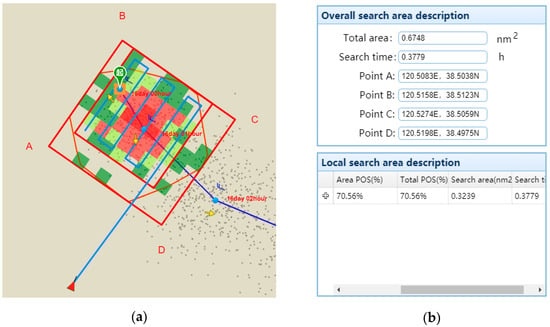
Figure 11.
Picture (a) is a visual display of the final search plan, and picture (b) is a description of each parameter in the search plan, including the overall search area parameters and local search area parameters.
3.5. Analytical Approach
In general, any area of containment must cover at least half of the points in the spatial distribution, regardless of the method used.
In the case of this article, the method used to define the confinement area is a technique that takes into account the numerical order of the size of the parent cell that comes from the ten-bit order.
This definition of the confinement area could also be based on 100 or 1000 if, and only if, the number of the parent cell was the same in numerical order.
Furthermore, according to the observations, the probability of confinement would depend indirectly on this confinement area because it was noticed that the value of the POC would be large if the confinement area was small.
As for the density ratio, this is considered an indicator because, from a value relatively equal to 0.7 to infinity, one can deduce that the POC would be valid to confirm the search in the containment area defined.
As for the analysis of the probability of detection, contrary to popular opinion, the effective or priority area is not within the containment area, rather, the containment area (A) is within the effective area (Z). This procedure was designed to optimize the results of the probability of detection. By comparing this procedure with the procedure of creating the effective area within the containment area, the difference in results will be quite clear. This is due to the difference between the surface values of the two methods. Thus, the larger the effective area than the containment area, the larger the POD value, and the smaller the effective area compared to the containment area, the smaller the POD value will be.
4. Discussion
4.1. Analysis of Algorithm
From the algorithm, this paper improves the calculation method of POC and POD. First, this paper introduces the concept of density ratio in the calculation method of POC. Compared with the traditional calculation method, considering more influencing factors in POC calculations, the calculation of POC is more accurate. Secondly, this paper uses the inverse cubic law visual detection function to calculate the POD. Compared with the traditional fixed-range detection function, the method adopted in this paper is relatively moderate, which can better reflect the relationship between detection probability and coverage, and improve the accuracy of POD calculation.
4.2. Analysis of Result
From the results, the method proposed in this paper shows a significant improvement in the solution results, compared with the traditional method. The comparative analysis method [37] is used to compare the advantages and disadvantages of the two methods.
4.2.1. Comparison of POC Calculation Results
According to Equation (5), the POC values under different scatter numbers are calculated and compared with the traditional calculation methods. The specific results are as follows:
As shown in Table 5, is the POC value based on the algorithm of this paper and is the POC value based on the traditional algorithm. It was noted that, for all values, the POC based on the method of the ratio of density was unquestionably superior to the POC based on the probability basic formula.

Table 5.
Comparison between and .
4.2.2. Comparison of POD Calculation Results
According to Equation (10), the POD value is compared and analyzed when the effective area is included and when the effective area is excluded. The specific results are shown in Table 6.

Table 6.
Effective area POD included in containment area.
As shown in Table 7, is the POD of the included effective area and is the POD of the excluded effective area. It is obvious that . So, the algorithm proposed in this paper has a greater advantage in calculating POD.

Table 7.
Comparison between and .
Through the above analysis, the effectiveness of the proposed algorithm in optimizing the search success rate can be verified. At present, the algorithm has been applied in China’s national maritime search and rescue support system, and the effect is strong.
5. Conclusions
This paper mainly studies the maritime search and rescue decision algorithm. The probability of containment (POC) and probability of detection (POD) were improved to increase the probability of success (POS). Among them, for the calculation of POC, the concept of density ratio is introduced on the basis of the original calculation method, which makes the calculation of POC more accurate. For the calculation of POD, a form of the random detection function is used to improve the calculation accuracy of POD. It can be seen from the comparison results that the values of POC and POD are significantly improved. Therefore, through the method proposed in this paper, the success rate and search efficiency of maritime search can be effectively improved. In the future, we should strengthen research on the allocation of search tasks, and form an efficient and complete search and rescue decision-making plan to provide reference for search and rescue activities.
Author Contributions
Conceptualization, B.A. and D.A.O.; methodology, D.A.O. and B.L.; software, B.A., B.L. and J.X.; validation, B.L. and J.X.; formal analysis, B.L.; investigation, B.L. and D.A.O.; resources, B.A., S.G. and X.C.; data curation, B.A.; writing—original draft preparation, B.L. and D.A.O.; writing—review and editing, B.A. and B.L.; visualization, B.A. and G.L.; supervision, B.A.; project administration, B.A.; funding acquisition, B.A. and S.G.
Funding
This work was supported by The National Key Research and Development Program of China (No. 2702017YFC1405006), the National Natural Science Foundation of China (No. 41401529).
Acknowledgments
The authors would like to acknowledge the State Oceanic Administration of China for providing ocean&weather forecasting data and drift prediction cases.
Conflicts of Interest
The authors declare no conflict of interest.
References
- Abi-Zeid, I.; Nilo, O. A Constraint Optimization Approach for the Allocation of Multiple Search Units in Search and Rescue Operations. INFOR 2011, 49, 15–30. [Google Scholar] [CrossRef]
- Ashton, C.; Shuster Bruce, A.; Colledge, G.; Dickinson, M. The Search for MH370. J. Navig. 2015, 68, 1–22. [Google Scholar] [CrossRef]
- Stone, L.D.; Keller, C.M.; Kratzke, T.M.; Strumpfer, J.P. Search for the wreckage of air France flight AF 447. Stat. Sci. 2014, 29, 69–80. [Google Scholar] [CrossRef]
- Koopman, B.O. The theory of search, Part III: The optimum distribution of searching effort. Oper. Res. 1957, 5, 613–626. [Google Scholar] [CrossRef]
- Kratzke, T.M.; Stone, L.D.; Frost, J.R. Search and Rescue Optimal Planning System. In Proceedings of the 2010 13th International Conference on Information Fusion, Edinburgh, UK, 26–29 July 2011; Volume 13, pp. 1–8. [Google Scholar]
- Koczkodaj, W.; Orlows, M. An Orthogonal Basis for Computing a Consistent Approximation to a Pairwise Comparisons Matrix. Comput. Math. Appl. 2009, 7, 41–47. [Google Scholar] [CrossRef]
- Xiao, W.J.; Du, P.J.; Gong, M.X.; Kang, X. An operational search and rescue model system for Shanghai coast and adjacent seas. Mar. Forecasts 2013, 30, 80–86. [Google Scholar]
- Wang, B.Y. Maritime Optimal Search Area Research. Master’s Thesis, Dalian Maritime University, Dalian, China, 2016. [Google Scholar]
- Ren, J.Y. An Optimum Search Method for Sea Targets. Master’s Thesis, Changchun University of Technology, Changchun, China, 2017. [Google Scholar]
- Kasyk, L.; Pleskacz, K. An Adaptation of an Algorithm of search and rescue operation to ship maneuverability. TRANSNAV 2015, 9, 265–269. [Google Scholar] [CrossRef]
- Abi-Zeid, I.; Frost, J.R. SARPlan: A decision support system for Canadian search and rescue operations. Eur. J. Oper. Res. 2005, 162, 630–653. [Google Scholar] [CrossRef]
- Liang, B.C.; Liu, X.; Li, H.J.; Wu, Y.J.; Li, D.Y. Wave Climate Hind casts for the Bohai Sea, Yellow Sea, and East China Sea. J. Coast. Res. 2014, 32, 172–180. [Google Scholar]
- Liu, Z. Research on Risk Evaluation System for Vessels in Yellow Sea and Bohai Sea during Severe Weather. Master’s Thesis, Dalian Maritime University, Dalian, China, 2015. [Google Scholar]
- Zhang, J.; Ângelo, P.T.; Soares, C.G.; Yan, X. Probabilistic modelling of the drifting trajectory of an object under the effect of wind and current for maritime search and rescue. Ocean Eng. 2017, 129, 253–264. [Google Scholar] [CrossRef]
- Fan, X.W. Study on SAR Environment at Sea. Master’s Thesis, Dalian Maritime University, Dalian, China, 2013. [Google Scholar]
- Devarakonda, R.; Wei, Y.X.; Thornton, M.M. Accessing and distributing large volumes of NetCDF data. In Proceedings of the IEEE International Conference on Big Data, Washington, DC, USA, 5–8 December 2017; pp. 3966–3967. [Google Scholar]
- Wollan, E. A Primer on Search and Rescue. 2007. Available online: www.Mindensoaringclub.com (accessed on 6 September 2007).
- Wang, C. Principles and Practices towards SAR Services: A Comparative Study on State’s Approaches to Improving Maritime SAR. Master’s Thesis, World Maritime University, Malmö, Sweden, 2006; pp. 1–105. [Google Scholar]
- Richardson, H.R.; Discenza, J.H. The United States Coast Guard Computer-Assisted Search Planning system (CASP). Naval Res. Logist. Quart. 1980, 27, 659–680. [Google Scholar] [CrossRef]
- Stone, L.D. Theory of Optimal Search; Harcourt Brace Jovanovich: New York, NY, USA; London, UK, 1975; pp. 1586–1589. [Google Scholar]
- Monaghan, J.J. Smoothed Particle Hydrodynamics. World Sci. 2003, 30, 543–574. [Google Scholar]
- Huang, J.; Xu, J.L.; Gao, S.; Guo, J.T. Analysis of Factors Affecting Migration Trajectory of Sea Drift Based on Offshore Test. Mar. Forecasts 2014, 31, 98–104. [Google Scholar]
- Soza Company, Ltd. The Theory of Search A Simplified Explanation; Office of Search and Rescue U.S. Coast Guard: Washington, WA, USA, 1996; p. 101.
- Burciu, Z. Bayesian methods in reliability of search and rescue action. Pol. Marit. Res. 2010, 17, 72–78. [Google Scholar] [CrossRef][Green Version]
- Yu, M.; Xu, Z.J. Optimal Search Algorithm for Missing Target Based on Bayesian Approach. Comput. Mod. 2016, 10, 21–29. [Google Scholar]
- Zhou, C.Y.; Zhao, Y.T.; Sun, Y.Z. Missile Aircraft Discovery Probability Model Based on Bayesian Information Update. Math. Model. Appl. 2015, 4, 71–78. [Google Scholar]
- Menon, A.K.; Ong, C.S. Linking losses for density ratio and class-probability estimation. In Proceedings of the International Conference on International Conference on Machine Learning, Canberra, ACT, Australia, 19 June 2016. [Google Scholar]
- Coppini, G.; Jansen, E.; Turrisi, G.; Creti, S.; Shchekinova, E.Y.; Pinardi, N.; Lecci, R.; Carluccio, I.; Kumkar, Y.V.; D’Anca, A.; et al. A new search-and-rescue service in the Mediterranean Sea: A demonstration of the operational capability and an evaluation of its performance using real case scenarios. Nat. Hazards Earth Syst. Sci. Discuss. 2016, 16, 2713–2727. [Google Scholar] [CrossRef]
- International Maritime Organization. International Aeronautical and Maritime Search and Rescue Manual; IMO: London, UK, 2013; p. 1086. [Google Scholar]
- Liao, G.X.; Li, M.F. A GIS based decision-making Support System for Maritime search and rescue. In Proceedings of the International conference on E-Business and E-Government, Guangzhou, China, 7–9 May 2010. [Google Scholar]
- Wu, X.; Zhou, J.H. Research on probability of detection in maritime search and rescue. J. Saf. Sci. Technol. 2015, 11, 28–33. [Google Scholar]
- Liu, G.Q. Study on Determining the Width of Sweeping Sea in Maritime Search. Master’s Thesis, Dalian Maritime University, Dalian, China, 2009. [Google Scholar]
- Xiao, F.B. Research on the Key Technologies of Maritime Search and Rescue Decision Support System. Ph.D. Thesis, Dalian Maritime University, Dalian, China, 2009. [Google Scholar]
- Xiao, F.B.; Yi, Y.; Jin, Y.C.; Zhang, X.Y. Determination of maritime search area based on random particle simulation. Navig. China 2011, 34, 34–39. [Google Scholar]
- Jie, L.; Yao, S.; Zhang, Z. Research on subareas division problem of maritime search and rescue based on improved Monte Carlo algorithm. In Proceedings of the 2013 IEEE International Conference on Mechatronics and Automation, Takamatsu, Japan, 4–7 August 2013; pp. 1464–1468. [Google Scholar]
- Samik, R. Introduction to Monte Carlo Simulation. In Proceedings of the 2008 Winter Simulation Conference, Austin, TX, USA, 12 July 2008. [Google Scholar]
- Ai, B.; Liu, Y.M.; Wang, Z.H.; Sun, D.C. Evaluation of multi-scale representation of ocean flow fields using the Euler method based on map load. J. Spat. Sci. 2019. [Google Scholar] [CrossRef]
© 2019 by the authors. Licensee MDPI, Basel, Switzerland. This article is an open access article distributed under the terms and conditions of the Creative Commons Attribution (CC BY) license (http://creativecommons.org/licenses/by/4.0/).